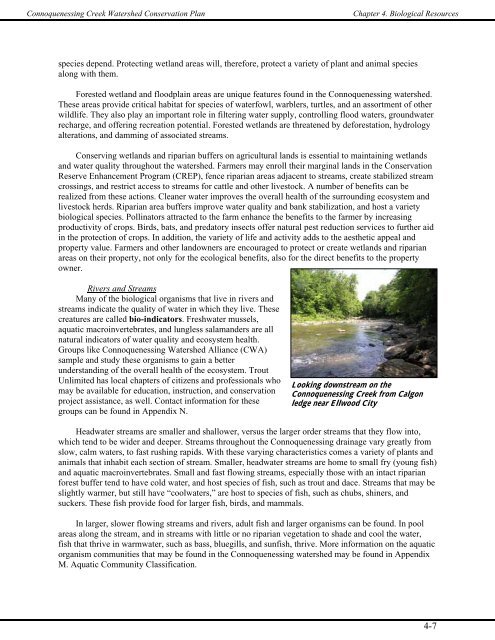CHAPTER 4 - Western Pennsylvania Conservancy
CHAPTER 4 - Western Pennsylvania Conservancy
CHAPTER 4 - Western Pennsylvania Conservancy
Create successful ePaper yourself
Turn your PDF publications into a flip-book with our unique Google optimized e-Paper software.
Connoquenessing Creek Watershed Conservation Plan<br />
Chapter 4. Biological Resources<br />
species depend. Protecting wetland areas will, therefore, protect a variety of plant and animal species<br />
along with them.<br />
Forested wetland and floodplain areas are unique features found in the Connoquenessing watershed.<br />
These areas provide critical habitat for species of waterfowl, warblers, turtles, and an assortment of other<br />
wildlife. They also play an important role in filtering water supply, controlling flood waters, groundwater<br />
recharge, and offering recreation potential. Forested wetlands are threatened by deforestation, hydrology<br />
alterations, and damming of associated streams.<br />
Conserving wetlands and riparian buffers on agricultural lands is essential to maintaining wetlands<br />
and water quality throughout the watershed. Farmers may enroll their marginal lands in the Conservation<br />
Reserve Enhancement Program (CREP), fence riparian areas adjacent to streams, create stabilized stream<br />
crossings, and restrict access to streams for cattle and other livestock. A number of benefits can be<br />
realized from these actions. Cleaner water improves the overall health of the surrounding ecosystem and<br />
livestock herds. Riparian area buffers improve water quality and bank stabilization, and host a variety<br />
biological species. Pollinators attracted to the farm enhance the benefits to the farmer by increasing<br />
productivity of crops. Birds, bats, and predatory insects offer natural pest reduction services to further aid<br />
in the protection of crops. In addition, the variety of life and activity adds to the aesthetic appeal and<br />
property value. Farmers and other landowners are encouraged to protect or create wetlands and riparian<br />
areas on their property, not only for the ecological benefits, also for the direct benefits to the property<br />
owner.<br />
Rivers and Streams<br />
Many of the biological organisms that live in rivers and<br />
streams indicate the quality of water in which they live. These<br />
creatures are called bio-indicators. Freshwater mussels,<br />
aquatic macroinvertebrates, and lungless salamanders are all<br />
natural indicators of water quality and ecosystem health.<br />
Groups like Connoquenessing Watershed Alliance (CWA)<br />
sample and study these organisms to gain a better<br />
understanding of the overall health of the ecosystem. Trout<br />
Unlimited has local chapters of citizens and professionals who<br />
may be available for education, instruction, and conservation<br />
project assistance, as well. Contact information for these<br />
groups can be found in Appendix N.<br />
Looking downstream on the<br />
Connoquenessing Creek from Calgon<br />
ledge near Ellwood City<br />
Headwater streams are smaller and shallower, versus the larger order streams that they flow into,<br />
which tend to be wider and deeper. Streams throughout the Connoquenessing drainage vary greatly from<br />
slow, calm waters, to fast rushing rapids. With these varying characteristics comes a variety of plants and<br />
animals that inhabit each section of stream. Smaller, headwater streams are home to small fry (young fish)<br />
and aquatic macroinvertebrates. Small and fast flowing streams, especially those with an intact riparian<br />
forest buffer tend to have cold water, and host species of fish, such as trout and dace. Streams that may be<br />
slightly warmer, but still have “coolwaters,” are host to species of fish, such as chubs, shiners, and<br />
suckers. These fish provide food for larger fish, birds, and mammals.<br />
In larger, slower flowing streams and rivers, adult fish and larger organisms can be found. In pool<br />
areas along the stream, and in streams with little or no riparian vegetation to shade and cool the water,<br />
fish that thrive in warmwater, such as bass, bluegills, and sunfish, thrive. More information on the aquatic<br />
organism communities that may be found in the Connoquenessing watershed may be found in Appendix<br />
M. Aquatic Community Classification.<br />
4-7














